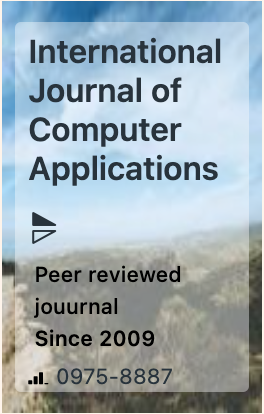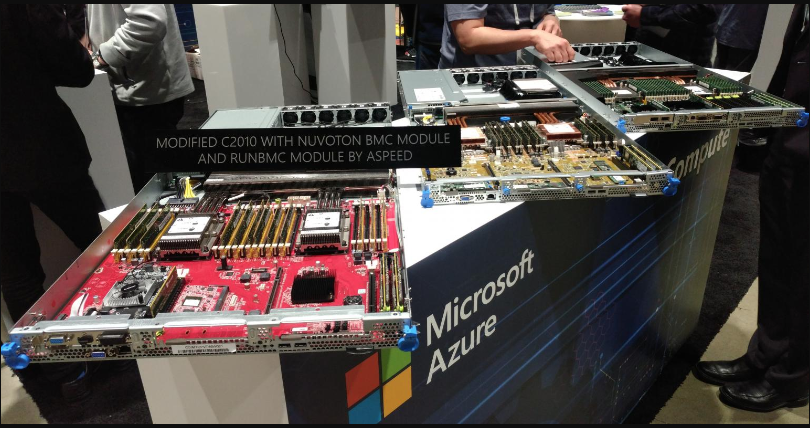The week's pick
Random Articles
Reseach Article
Performance Investigation of Capacity Enhancement Algorithm for IEEE 802.11 Wireless Ad-hoc Networks

| International Conference and Workshop on Emerging Trends in Technology |
| Foundation of Computer Science USA |
| ICWET - Number 6 |
| None 2011 |
| Authors: Satish Ket, R. N. Awale |
Satish Ket, R. N. Awale . Performance Investigation of Capacity Enhancement Algorithm for IEEE 802.11 Wireless Ad-hoc Networks. International Conference and Workshop on Emerging Trends in Technology. ICWET, 6 (None 2011), 37-44.
Abstract
The performance of IEEE 802.11 with different network densities and protocol configurations is of interest, particularly in distributed coordination function (DCF) mode. A mathematical model for single hop network IEEE 802.11 protocol was introduced by Bianchi [1] to analytically derive the saturated throughput. The ultimate goal is to enhance the capacity of Ad-hoc network closer to the analytical values of this model. As an attempt, the Receiver Based Capacity Enhancement Algorithm using Cross-Layer Design Approach (RCECLD) is proposed which dynamically adapts the data rate. It uses Signal-to-Noise Ratio (SNR) values calculated by Physical layer and exported to Medium Access Control (MAC) layer via the cross-layer interface to estimate the prevailing channel state. In RCECLD the receiver decides the transmission data rate by calculating the SNR value of received RTS (Ready-to-Send), which is in turn an estimate of the prevailing channel state, and piggybacking it through CTS (Clear-to-Send) to the transmitter. Accordingly, transmitter transmits the data frame with adopted data rate.
References
- Bianchi, G., 2000. Performance Analysis of the IEEE 802.11 Distributed Coordination Function. IEEE Journal on Selected Areas in Communications. 18, 3 (Mar. 2000), 535–547.
- Kamerman, A., and Monteban, L. 1997. WaveLAN -II: a high-performance wireless LAN for the unlicensed band. Bell Labs Technical Journal, (Summer 1997), 118–133.
- IEEE, Part 11: Wireless LAN Medium Access Control (MAC) and Physical Layer (PHY) Specifications. IEEE Standard 802.11-1999, (Aug. 1999).
- IEEE 802.11b, Part 11: Wireless LAN Medium Access Control (MAC) and Physical Layer (PHY) Specifications: High-speed Physical Layer Extension in the 2.4 GHz Band. Supplement to IEEE 802.11 Standard, (Sept. 1999).
- Balachandran, K., Kadaba, S.R.,and Nanda, S. 1999. Channel quality estimation and rate adaptation for cellular mobile radio. IEEE JSAC. 17, 7, 1244–1256.
- Holland, G., Vaidya, N., and P. Bahl. 2001. A Rate Adaptive MAC Protocol for Multi-hop Wireless Networks. ACM MOBICOM’01. Rome, Italy, 236-251.
- Sadeghi, B., Kanodia, V., Sabharwal A., and Knightly, E. 2005. OAR: Opportunistic media access for multi-rate ad hoc networks. IEEE/ACM Transactions on Wireless Networks. 11, 1-2, 39-53.
- Gupta P. and Kumar P. R., 2000. The Capacity of Wireless Networks. IEEE Transactions on Information Theory, 46(2): 388–404, (March 2000).
- Conti, M., Maselli, G., and Turi, G. 2004. Cross-Layering in a Mobile Ad-hoc Network Design. IEEE Comp. Soc.37, 2, 48-51 (February 2004).
- Jongseok Kim, Seongkwan Kim, Sunghyun Choi, and Daji Qiao, 2006. CARA: Collision-Aware Rate Adaptation for IEEE 802.11 WLANS. In Proc. IEEE INFOCOM 2006, 1-11, Barcelona, Spain. (April 2006).
- Chevillat, P., Jelitto, J., Noll Barreto, A. and Truong. H. L., 2003. A Dynamic Link Adaptation Algorithm for IEEE 802.11a Wireless LANs. In Proc. IEEE ICC’03. 1141-1145, Anchorage, AK, (May 2003).
- Daji Qiao and Sunghyun Choi, 2005. Fast-Responsive Link Adaptation for IEEE 802.11 WLANs. In Proceedings IEEE ICC’05, vol.5, 3583-3588, Seoul, Korea. (May 2005).
- Jinyang Li, Charles Blake, Douglas S. J., De Couto, Hu Imm Lee, Robert Morris, 2001. Capacity of Ad Hoc Wireless Networks. In Proceedings of the ACM MOBICOM’01, Rome, Italy, 61-69.
- Timothy J., Shepard, 1996. A channel access scheme for large dense packet radio networks. In Proceedings of the ACM SIGCOMM Conference (SIGCOMM ’96), 219–230, (August 1996}.
- Matthias Grossglauser and David Tse, 2002. Mobility Increases the Capacity of Ad-hoc Wireless Networks. IEEE/ACM Transactions on Networking, 10, 4, 477-486.
- Thyagarajan Nandagopal, Tae-Eun Kim, Xia Gao, and Vaduvur Bharghavan, 2000. Achieving MAC Layer Fairness in Wireless Packet Networks. In Proceedings of the ACM/IEEE MobiCom, 87–98, (August 2000).
- Rappaport, T. S. 1999. Wireless Communications: Principles and Practice. Prentice Hall.
- Ratish, J., Punnoose, Pavel V., Nikitin, and Daniel, D. Stancil. 2000. Efficient Simulation of Ricean Fading within a Packet Simulator. In Proceedings of the IEEE VTC’00-Fall. 2 (Sept. 2000), 764-767.
- Heusse, M., Rousseu, F., Berger G., Sabbatel, and Duda, A. 2003. Performance Anomaly of 802.11b. IEEE INFOCOM’03. 2 (Mar. 2003), 836-843.
Index Terms
Keywords
